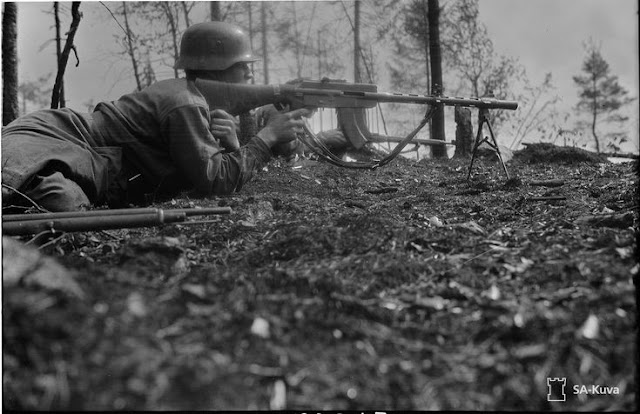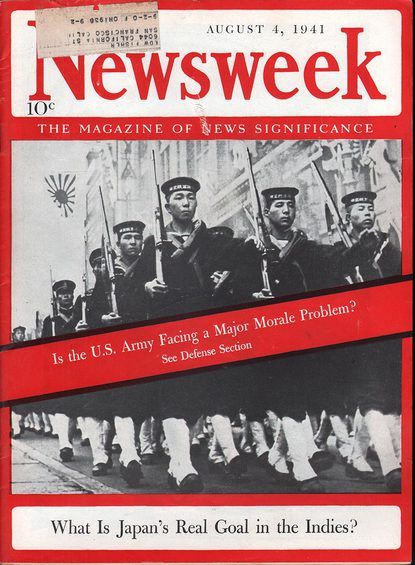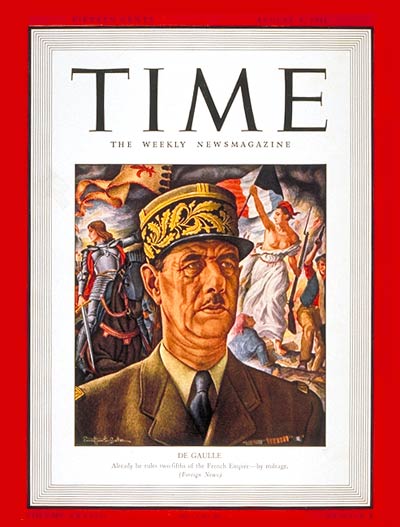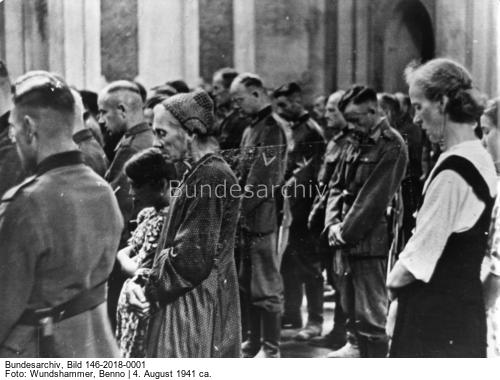Monday 4 August 1941
 |
| Adolf Hitler meets with Army Group Center commander Field Marshal Fedor von Bock, 4 August 1941. |
Hitler seems unsure of the future direction of the campaign, at least according to some in attendance. At these conferences with Hitler, the generals invariably choose one man to put forth their own point of view, and today that is Colonel-General Guderian. Guderian, who has led the advance toward Moscow with Panzer Group 2, later recalls that Hitler wants to take Leningrad first, but is undecided between Moscow and Ukraine:
He seemed to incline toward the latter target for a number of reasons: first, Army Group South seemed to be laying the groundwork for victory in that area; secondly, he believed that the raw materials and agricultural produce of the Ukraine were necessary to Germany for the further prosecution of the war; and finally, he thought it essential that the Crimea, ‘that Soviet aircraft carrier operating against the Rumanian oilfields’ be neutralized.Based upon sheer conjecture buttressed by faulty staff work at army headquarters (OKH), Guderian opines that the Soviet Union is running out of manpower. Thus, Moscow should come next in order to force the Red Army to commit the last of its troops.
 |
| Adolf Hitler at headquarters of Army Group Center in Borisov, Belarus on August 4, 1941. |
Guderian decides to make the decision about future strategy himself rather than wait for formal orders. On the flight back to his headquarters, Guderian prepares plans for a continuation of the offensive toward Moscow using all of his troops. In this, he feels confident because all around him - von Bock, OKH Chief of Staff Franz Halder, Panzer Group 3 commander Hermann Hoth, and commander in chief of the army Field Marshal Walter von Brauchitsch - agree that Moscow should be the next objective. Everyone is sure that Hitler will come around to their point of view.
 |
| A Finnish soldier aiming an M/26 machine gun, August 4, 1941 (SA-Kuva). |
In the Army Group South sector, Kirovohrad falls to the Germans. Soviet 5th Army counterattacks the German 6th Army south of Kyiv but makes no progress. Soviet 9th and 18th armies are told to retreat behind the Bug River once they realize they cannot relieve the Uman pocket. Since this already is the situation, the 9th Army begins retreating toward Nikolayev and 18th toward Nikopol. The Germans (XIV Corps) already are across the Bug and heading south to cut off both armies.
German soldier Karl Fuchs sends a letter today to his father, who is serving elsewhere on the front. It reads in part:
The pitiful hordes on the other side are nothing but felons who are driven by alcohol and the threat of pistols pointed at their heads. There is no troop morale and they are at best cannon fodder.and
Having encountered these Bolshevik hordes and having seen how they live has made a lasting impression on me. Everyone, even the last doubter, knows today that the battle against these subhumans, who’ve been whipped into a frenzy by the Jews, was not only necessary but came in the nick of time.Supply problems are becoming an issue in the Wehrmacht. After the generals tell him of the supply situation at their meeting, Hitler agrees to allocate an entire month of war production to the Eastern Front. In terms of tanks, this means only 35 new machines and 400 tank engines (which must be replaced regularly). This does not keep up with wastage and ordinary wear and tear.
 |
| A Finnish marksman with a Mosin-Nagant rifle, August 4, 1941 (SA-Kuva). |
East African Campaign: After a long period of quiet, there is some action in East Africa. While the British and their local allies have evicted the Italians from the coast and most of their inland strongholds, Mussolini's Italian forces do still control a few strong points in the mountains. One of these is Gondar, in the northern part of Abyssinia. Today, the South African Air Force swings into action and begins a daily bombing campaign that lasts until 6 August.
Battle of the Baltic: German bombers of KG4 drop 16 LMB mines in the Irben Strait and 16 LMB imines in the mouth of the river Triigi.
Soviet minesweeper T-201 Zariad hits a mine and sinks at Ristna beacon.
Dutch fishing boat Sumatra hits a mine and sinks north of Kolberg, Germany.
 |
| August 4, 1941: Hornet CV-8 under construction at Newport News Shipbuilding. |
Royal Navy aircraft carrier HMS Victorious sends three Fulmar planes to attack Tromsø, Norway. One of the planes is shot down and the crew is captured.
A Luftwaffe Focke-Wulf Fw-200 bombs and sinks 4337-ton British freighter Tunisia in the mid-Atlantic south of Iceland and west of Ireland. Tunisia's valuable cargo of manganese ore is lost. There are five survivors and 38 deaths.
Royal Navy escort ship Banff (a former US coast guard cutter) collides with a lighter in the Thames Estuary and sustains some damage. Banff returns to Tilbury for repairs.
Royal Navy patrol ship Cavina intercepts 5522-ton German blockade runner Frankfurt west of the Azores. Frankfurt's crew scuttles the ship rather than surrender it. Two lifeboats are launched by the Frankfurt, and the Cavina picks up one with 26 men. The other lifeboat refuses to be taken aboard and is never seen again.
Having delivered its good at Archangel, Royal Navy minelayer Adventure departs, escorted by two Soviet destroyers.
Royal Navy submarine Tigris arrives at Polyarny, Russia in order to conduct patrols from there off the coast of northern Finland and Norway.
The Royal Navy sinks floating crane AC-6 in Skerry Sound in Scotland as a blockship in order to block access to Scapa Flow.
Royal Navy minesweeper HMS Sidmouth (Commander Henry T. Rust) is commissioned.
Canadian minesweeper HMCS Malpeque (Lt. Leslie L. Foxall) is commissioned.
US Navy light cruiser USS Houston is laid down.
U-523 is laid down.
Battle of the Mediterranean: The Luftwaffe strafes Royal Navy minesweeping whaler Sotra off Mersa Matruh. There is one death.
Royal Navy destroyers HMS Jaguar and Nizam make the nightly run to Tobruk.
An Axis supply convoy departs from Naples bound for Tripoli, while one also departs from Tripoli bound for Naples.
The Luftwaffe attacks Ismailia, Egypt.
At Malta, Governor Dobbie announces that olive oil is going to be rationed. This sorely disappoints the Maltese people, who use a lot of olive oil in cooking.
 |
| August 4, 1941: Hornet CV-8 under construction at Newport News Shipbuilding. |
Japanese 16,975-ton liner Tatsuta Maru departs from San Francisco for Tokyo. The Americans have made an exception to their sanctions against Japan to refuel the Tatsuta Maru in order for it to return to Japan.
Japanese freighter Heian Maru departs Seattle and heads back to Japan.
Spy Stuff: The Japanese are keeping a close eye on US activities throughout the Pacific. Today, they learn that about 600 US soldiers have arrived in Manila aboard transport USS President Coolidge.
Ambassador Nomura reports to Tokyo that anti-Japanese sentiment (as reflected in a published Gallup poll) is high and that the US newspapers are in full support of the US government position on Japan. In his cable to Tokyo, Nomura asks to be sent a "Foreign Office expert" who is familiar with "the Government's high policy" because he does not know what the government truly wants.
Tokyo sends out a circular that covers proper procedures for the destruction of obsolete codes and the proper care of current codes.
 |
| Newsweek, 4 August 1941, Cover story: "What is Japan's Real Goal in the Indies?" |
Welles also mentions that he had received "reports" that Japan intended to move further south into Thailand. This would cause further problems in US/Japanese relations. He also states that the "basic principle of the future" would be free trade, with equal accessibility to raw materials by all countries.
 |
| Life magazine, 4 August 1941, cover story "British Women." |
Soviet/Polish Relations: In a sign of goodwill to the Polish government-in-exile in London, the Soviets release General Władysław Anders from prison.
German/Italian Relations: The Germans and Italians agree on terms under which the Italian expeditionary forces will operate on the Eastern Front.
 |
| Time magazine, 4 August 1941, Cover Credit: Ernest Hamlin Baker. |
The Ryan Aeronautical Company NR-1 trainer plane takes its first flight. It is a low-wing monoplane with a metal fuselage, unlike most other trainers at this time. This is part of a huge expansion of the US Navy training of pilots during this period of time. The Ryan NR-1 will equip NAS Jacksonville.
Mark Clark is appointed Assistant Chief of Staff (G-3) at US Army General Headquarters and promoted to Brigadier General.
US Government: President Roosevelt continues his "fishing trip" off the northeast coast. While that is what the White House has told reporters it is, in fact, Roosevelt has other plans. Aboard presidential yacht USS Potomac (AG 25), Roosevelt sails today from Point Judith, Rhode Island to South Dartmouth, Massachusetts. There, Crown Prince Martha of Norway and her party board. There apparently is some fishing during the day, but that is not the point of the trip. Then, after Martha returns to shore, Roosevelt sails up to Menemsha Bight, Vineyard Sound, Massachusetts. There, as planned, await US heavy cruisers Augusta (CA-31) and Tuscaloosa (CA-37), along with five destroyers.
 |
| "Prime Minister Winston Churchill on board HMS PRINCE OF WALES during his journey to America to meet with President Roosevelt. The quadruple 14-inch guns of Y turret can be seen in the background." © IWM (H 12784). |
 |
| Soviet Union, Vitebsk - A military service, with German soldiers and local women standing in the church (Wundshammer, Benno, Federal Archive, Bild 146-2018-0001). |
American Homefront: Mickey Owen of the Brooklyn Dodgers became the first catcher to successfully handle three foul pop-ups during the same inning.
 |
| New York Yankees Joe DiMaggio and Lefty Gomez, right, during at call at Treasury House in Washington, Aug. 4, 1941. They have offered to autograph books of defense savings stamps. (AP Photo). |
August 1941
August 2, 1941: Uman Encirclement Closes
August 3, 1941: Bishop von Galen Denounces Euthanasia
August 4, 1941: Hitler at the Front
August 5, 1941: Soviets Surrender at Smolensk
August 6, 1941: U-Boats in the Arctic
August 7, 1941: Soviets Bomb Berlin
August 8, 1941: Uman Pocket Captured
August 9, 1941: Atlantic Conference at Placentia Bay
August 10, 1941: Soviet Bombers Mauled Over Berlin
August 11, 1941: Rita Hayworth in Life
August 12, 1941: Atlantic Charter Announced
August 13, 1941: The Soybean Car
August 14, 1941: The Anders Army Formed
August 15, 1941: Himmler at Minsk
August 16, 1941: Stalin's Order No. 270
August 17, 1941: Germans in Novgorod
August 18, 1941: Lili Marleen
August 19, 1941: Convoy OG-71 Destruction
August 20, 1941: Siege of Leningrad Begins
August 21, 1941: Stalin Enraged
August 22, 1941: Germans Take Cherkassy
August 23, 1941: Go to Kiev
August 24, 1941: Finns Surround Viipuri
August 25, 1941: Iran Invaded
August 26, 1941: The Bridge Over the Desna
August 27, 1941: Soviets Evacuate Tallinn
August 28, 1941: Evacuating Soviets Savaged
August 29, 1941: Finns take Viipuri
August 30, 1941: Operation Acid
August 31, 1941: Mannerheim Says No
2020
No comments:
Post a Comment